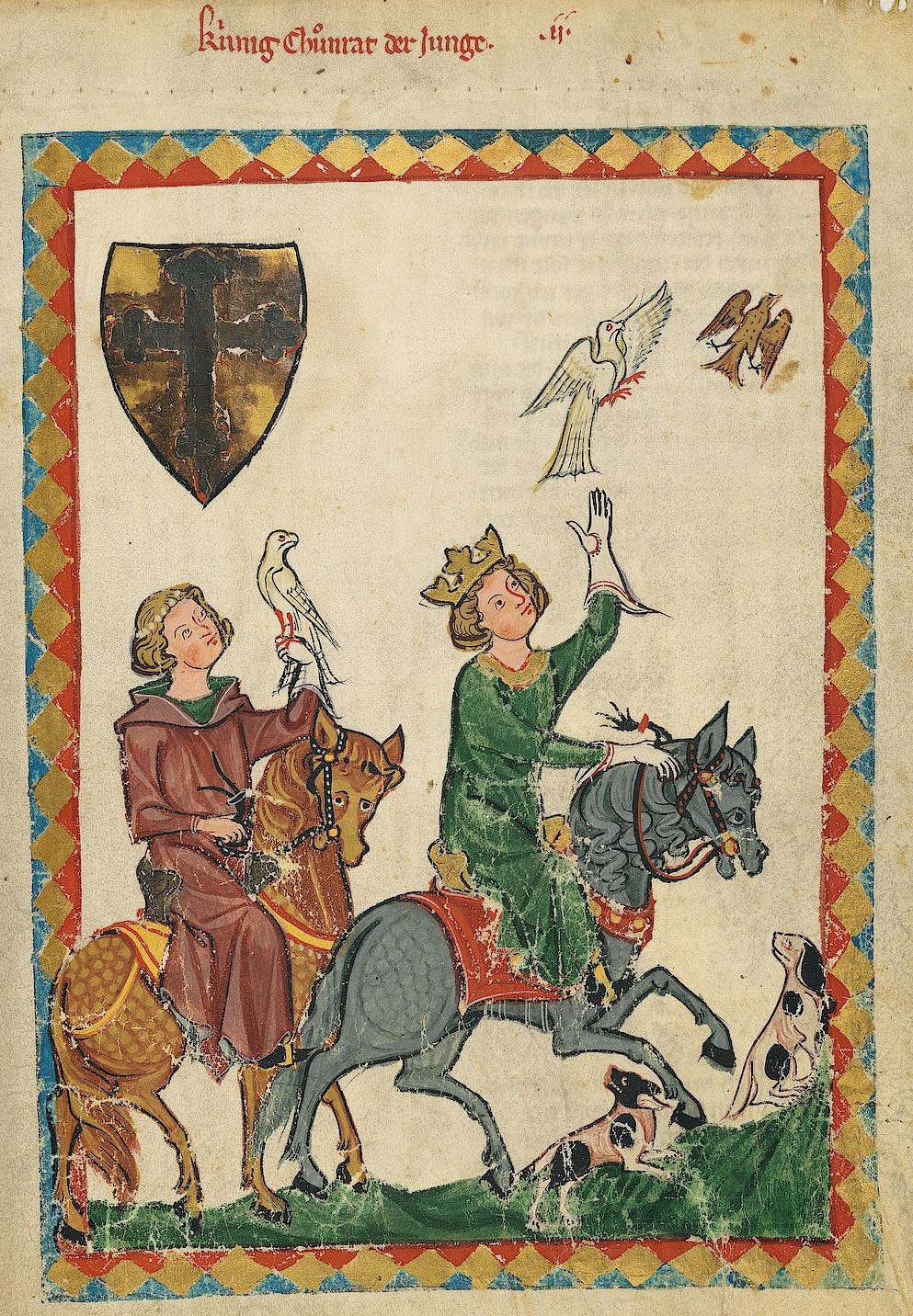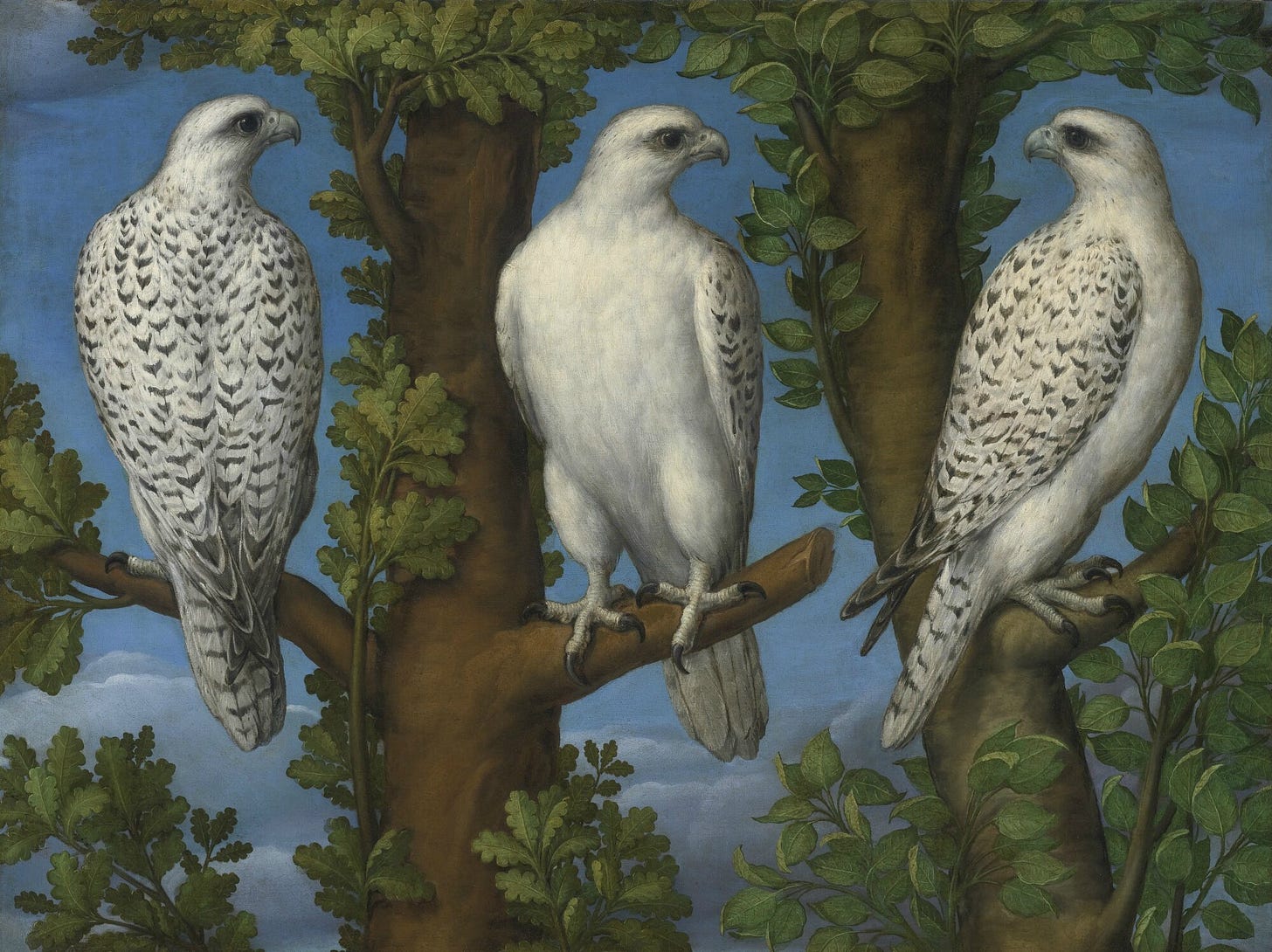The Prestige of Gyrfalcons in the Middle Ages
In the Middle Ages, falcons were an aristocratic symbol of prestige and the best falcons were very expensive. The most sought-after were the gyrfalcons.
Hunting with falcons was very popular among medieval aristocracy. It was not just a sport but also had a very important role in the social interaction of aristocracy since it offered the possibility of a loose and informal meeting of influential nobles. Hunting was one of the most common ways to entertain guests arriving in noble courts.
Falconry was also very expensive, for the acquisition and upkeep of these animals was costly. Capturing and training wild falcons was a delicate and time-consuming task. The care of the falcons was entrusted to specialists, the falconers, who also carried out the everyday training of these birds of prey. The costs of all of this made falcons animals of prestige and a status symbol. In medieval illuminations, aristocratic figures were often portrayed holding falcons as a sign of their status.
But the finest falcons were only found in specific regions, and were very expensive to obtain in most parts of Europe. Such was the case with the gyrfalcon. The gyrfalcon (Falco rusticolus) is exclusively an animal of the north, inhabiting an area from Greenland to Siberia. This rare exotic animal from the lands of darkness attracted a lot of fascination in Europe and Muslim lands. Medieval falconers were very curious about this bird, for they considered the gyrfalcon as one of the very best raptor species for falconry. The gyrfalcon is the largest of all European falcons and it could be trained to capture spectacular game. Its unique properties of strength, courage, speed and audaciousness were connected to the harshness of the northern climate.
This majestic bird was praised by medieval European and Arab writers. In his famous falconry treatise written in the 1240s, De arte venandi cum avibus (The Art of Hunting with Birds), Emperor Frederick II stated that "the gyrfalcon is the nobler among the species of falcons" (in genere falconum girofalcus nobilior est). The anonymous Arab author who at around the same time wrote the popular five-chapter treatise on falconry, the Moamyn, says that the gyrfalcon is the first kind of falcon, as it is the noblest.
But capturing gyrfalcons was a very difficult task. Scandinavians began specializing in capturing and trading falcons, as well as sending them as diplomatic gifts. Around year 1225, the King of Norway, Haakon IV, sent hunters to Iceland in order to catch gyrfalcons for the King of England, Henry III. The expedition took two years and brought back three white and ten grey gyrfalcons, which were sent to England. In a letter to the English king, Haakon explains that this expedition was very tough, for the sailors had to struggle against extreme climatic conditions in the Northern Ocean, which was incredibly cold. For these reasons, Henry had to consider these birds more precious than gold and silver, and had to appreciate the precious gift he received.
The transport of these delicate animals was difficult and required complex logistics. Frederick II complained about bad condition of birds on their arrival. In 1378, a merchant from Lubeck charged to transport the falcons to Venice was forced to vouch for the life of the birds and refund the complete price of each dead gyrfalcon. In 1420, the Count Palatine of the Rhine complained about receiving injured falcons. This was especially problematic when gyrfalcons were sent as diplomatic gifts, as sending a damaged or dead falcon could have the opposite effect as intended, causing disappointment.
But as trading with falcons became a prosperous business logistics were generally well organized. Trading gyrfalcons to the Muslim part of the Mediterranean was especially profitable. Arab and Persian falconers praised gyrfalcons and valued them as much as European nobility, if not even more. Muslim Sultans would pay very high prices to buy European gyrfalcons, especially the white ones. There was a high demand for gyrfalcons in Egypt, as they became a fashion among the Mamluk elite. Venetian merchants were deeply involved in this trade and often served as intermediaries between Hanseatic cities such as Lubeck, which traded with gyrfalcons, and Alexandria. In 1317, one Venetian merchant sold more than a hundred gyrfalcons to the Sultan of Egypt and earned a lot of wealth. In 1327, a merchant from Montpellier named Guillaume Bonnesmains brought more than a hundred gyrfalcons to Egypt which delighted the Mamluk emirs.
Gyrfalcons were also very important as diplomatic gifts. Europeans rulers often received and sent falcons as gifts. The Teutonic Order in particular frequently sent gyrfalcons as diplomatic gifts to various influential people over Europe in order to secure their political goals and improve diplomatic relations. Due to its geographical position, the Order was able to obtain these birds easier due to networks created by the Hanseatic trade with the nearby Scandinavian and Russian territories. These rare specimens were then sent to European nobles and monarchs, for most of whom getting such falcon would have been an impossible task because of the distance and costs involved. In this manner, the Teutonic Order was able to exploit the popularity of falconry and the exotic gyrfalcons to benefit their diplomacy. They sent falcons to kings of Poland, Hungary and France, and to various princes in Germany, as well as to important figures in the Catholic Church hierarchy. They also awarded falcons to lesser nobles who ventured to the Baltics to assist them in crusading.
Sources:
Thierry Buquet, "The Gyrfalcon in the Middle Ages, an Exotic Bird of Prey (Western Europe and Near East)" in Falconry in the Mediterranean Context During the Pre-modern Era (Bibliotheca Cynegetica, 2021), 79-98.
Benjámin Borbás, "Falcons in Service of the Teutonic Order at the Turn of the Fourtheent-fifteenth Century" in Annual of Medieval Studies at CEU, vol 26 (2020), 133-149.






Loved this piece!!!